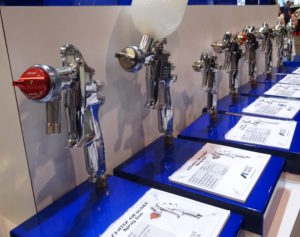
‘Who Pays?’: Several refinish operations frequently paid by Top 10 auto insurers
By onBusiness Practices | Education | Insurance | Market Trends | Repair Operations
The “Who Pays for What?” surveys demonstrate the fallacy of insurers claiming they never reimburse certain items or see other auto body shops charging for them.
The latest results from the January refinish survey indicate multiple operations for which such an assertion would be especially off-base.
In these instances, around 75 percent or even a larger proportion of the responding shops said they’re paid “always” or “most of the time” whenever they request reimbursement for certain line items. (Though there is a 3.1 percent margin of error.)
The survey drew hundreds of answers from auto body shops about how consistently eight of the nation’s largest insurers agreed to pay.
Here’s some highlights from that list; see others by downloading the entire April refinish report. The data should help consumers or auto body shops quickly end any arguments against those operations from Allstate, Farmers, GEICO, Liberty Mutual, Nationwide, Progressive, State Farm or USAA personnel.
Help the industry by taking the current “Who Pays for What?” survey on not-included body repair operations before the end of the day today. All answers are kept confidential; data is published only in the aggregate.
Prep raw plastic parts
“All the Toyota / Lexus (and some Hyundai) plastic bumper covers are sold as raw plastic,” survey co-author Mike Anderson wrote in the report. “But keep in mind that bumper covers are not the only plastic parts that are sold as raw plastic. I’ve seen some raw plastic grilles and cladding. CCC, Mitchell and AudaExplore all have predetermined times for prepping raw plastic parts. AudaExplore is 20 percent of the basecoat time (with a minimum of two-tenths), CCC is 25 percent of the basecoat time (with a maximum of an hour) and Mitchell is 20 percent of the basecoat time (with no minimum or maximum).
About 74 percent of the more than 700 responding shops said they were paid “always ” or “most of the time,” up 1.2 percentage points from last year.
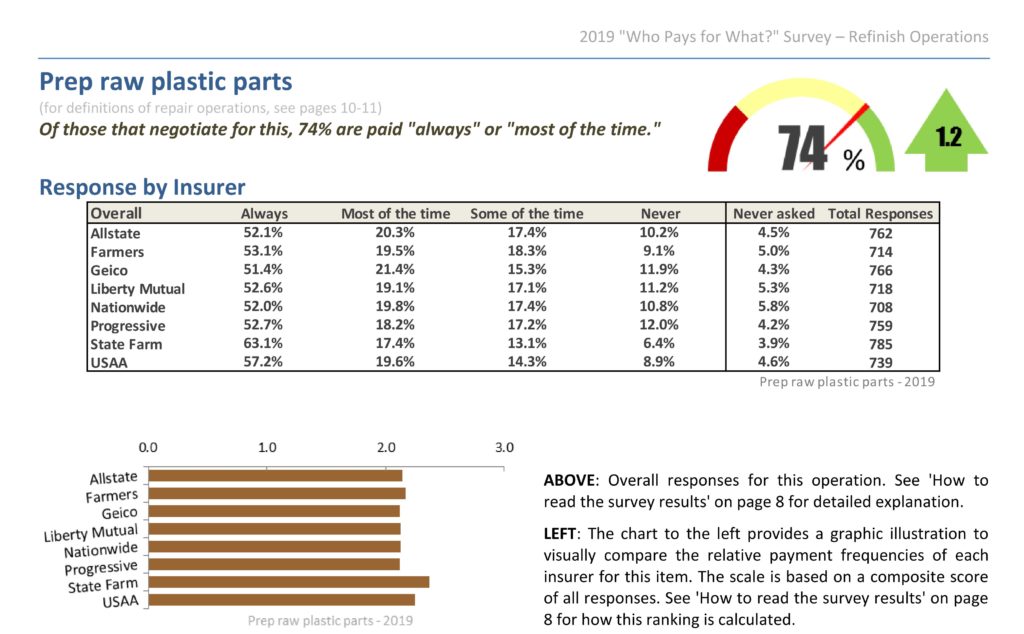
Blend adjacent panels
An insurer who claims his or her carrier doesn’t pay to blend adjacent panels probably ought to go back to adjuster school, based on the survey results.
About 92 percent of several hundred shops were likely to be paid by the carriers when they asked. State Farm, in fact, “always” pays for the work 80.7 percent of the time shops ask — nearly 90 percent of the time if a DRP shop asks.
The Database Enhancement Gateway, which also contributes to the “Who Pays?” reports, provided a link to an interesting inquiry on this topic from back in 2008.
A user had asked if blending the fuel door would be included in the quarter panel refinish time for a 1994 Lexus ES 300.
“I WAS TOLD IT WAS INCLUDED BUT I COULDN’T FIND THAT INFORMATION,” the user wrote.
“The blend time for the fuel door is Not Included, due to collision scenarios where the quarter panel is damaged but the fuel door is not damaged and does not require refinish,” CCC wrote at the time.
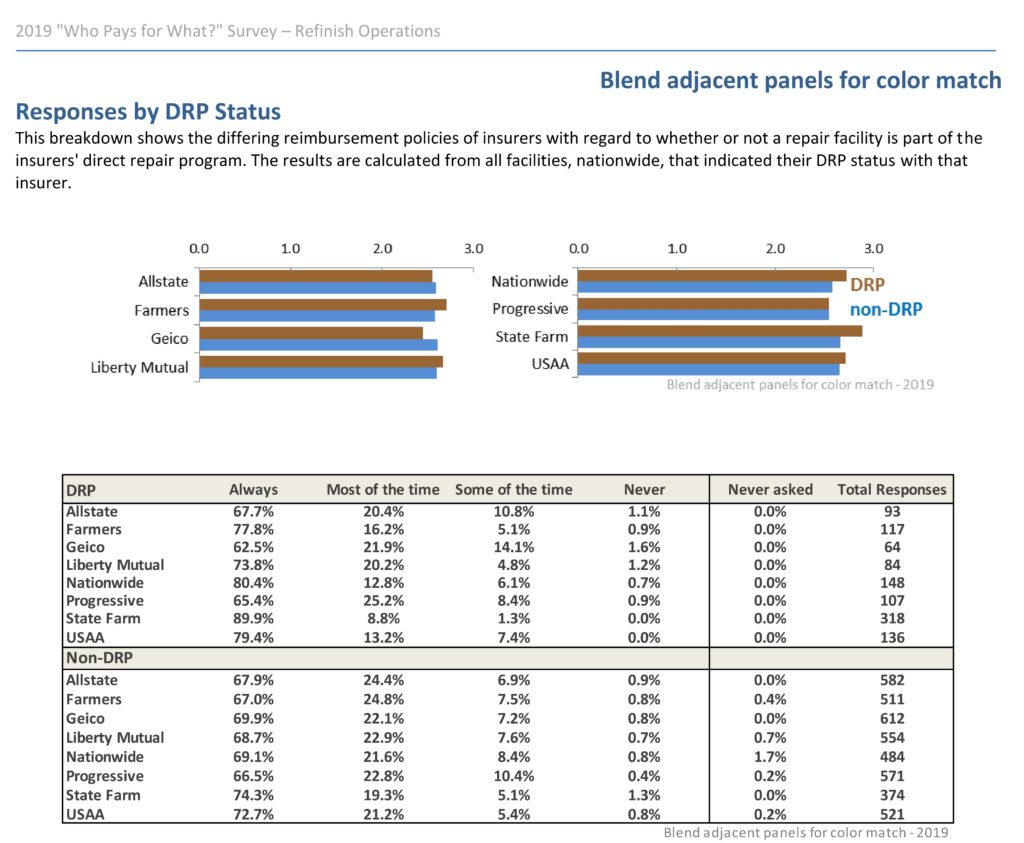
Gravel guard
Ninety percent of the polled shops said the insurers “always” or “most of the time” pay to apply gravel guard or rough coat. Nationwide, State Farm and USAA “always” paid it more than 80 percent of the time for DRP shops, the study found.
Anderson indicated some body shops might overlook the procedure, though few respondents reported they’d never asked the eight carriers for reimbursement.
“I think some estimators leave this off because they haven’t been trained to get down to look at the bottom of the fender or rocker,” Anderson wrote. “As a rule of thumb, if a vehicle does not have any rocker covers, it probably has gravel guard.”
However, only 42 percent of shops said they consistently see reimbursement for matching the OEM gravel guard texture.
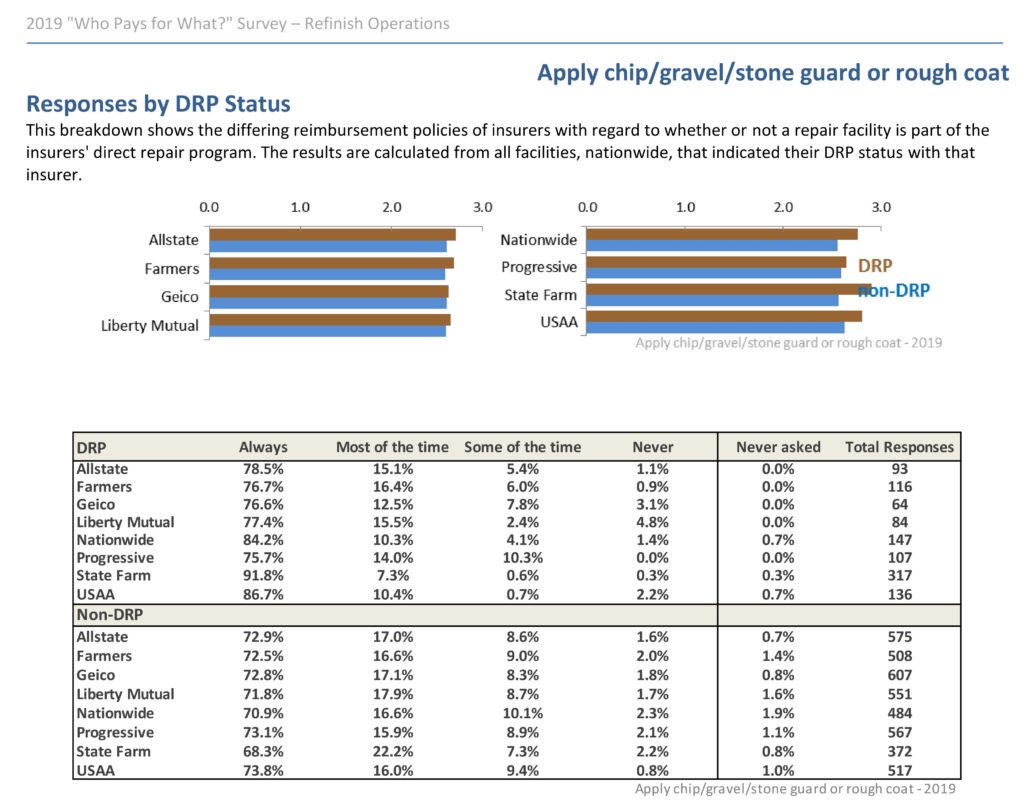
Extend clear to breaking point
About 82 percent of shops say they’re “always” or “most of the time” paid to extend clearcoat to its natural break.
It’s a little sad this still isn’t 100 percent, for paint manufacturers polled by SCRS (see here and here) clearly say you need to do it to keep the refinish company’s warranty. Valspar even told SCRS the clear coat might have to spread farther than even a single quarter panel in certain cases.
“Valspar does not recommend or warranty the blending of clear coats. Over reduction or solvent blending of a clear coat will become visible over time due to UV exposure on the blended edge. The edge may also fade or peel over time due to the minimal film thickness of the blended edge,” the manufacturer wrote in 2014.
“Valspar recommends applying clear coat to the entire panel. Many of today’s late model cars do not have a distinct edge or break line on the quarter panel, in these cases, Valspar recommends applying the clear coat to the roof and the opposite quarter panel.”
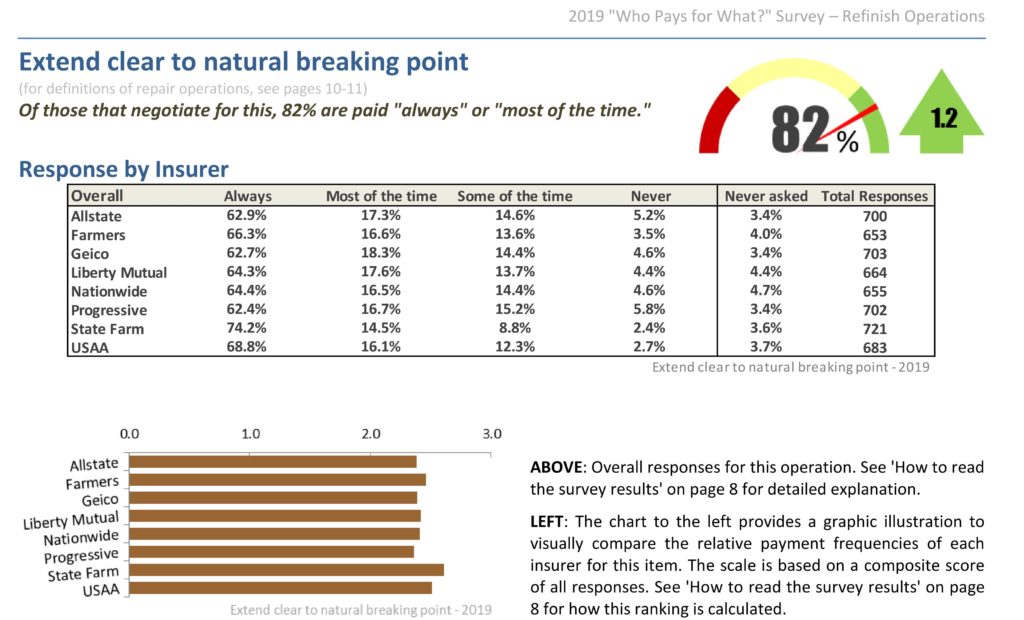
More information:
Take the 2019 body operations “Who Pays for What?” survey
January 2019 “Who Pays for What?” refinish results
SCRS paint manufacturer information
Paint manufacturer information on Collision Advice
Images:
Spray guns are seen at the Anest Iwata booth at SEMA 2018. (John Huetter/Repairer Driven News)
The January 2019 “Who Pays for What?” polling examined various refinish operations. (Provided by CRASH Network and Collision Advice)
